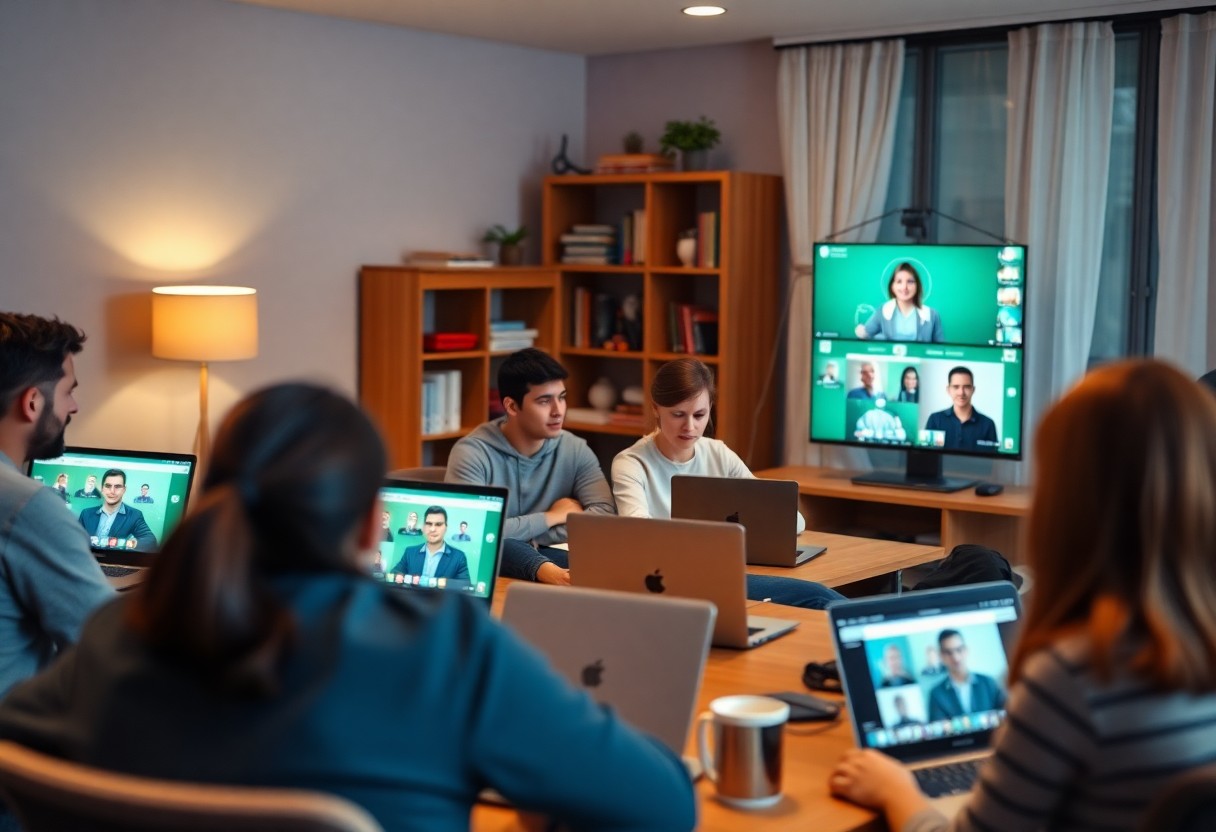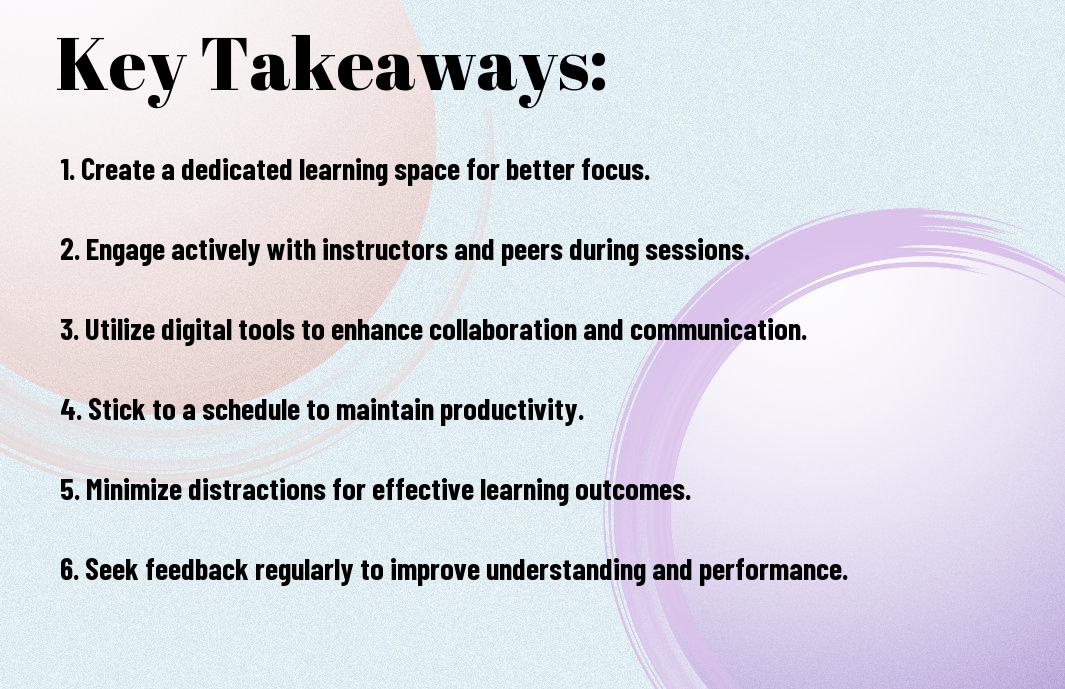As you step into the virtual classroom, you’re about to begin on a new learning journey. You’ll need to adapt and evolve to succeed. To help you thrive, you can explore Student Engagement Strategies for Virtual Classroom Success and discover how to make the most of your online education. Your path to success starts here, with practical advice and expert insights to guide you through the virtual learning landscape.
Key Takeaways:
To achieve success in virtual classrooms, consider the following points:
- Establish a Virtual Routine to maintain a sense of structure and normalcy for students, helping them stay engaged and motivated throughout the learning process.
- Utilize Interactive Tools such as video conferencing software, online whiteboards, and collaboration platforms to facilitate Real-Time Feedback and encourage student participation.
- Foster a Supportive Learning Environment by promoting open communication, addressing technical issues promptly, and providing Personalized Support to students who need it.
- Develop Engaging Content that incorporates multimedia elements, such as videos and gamification, to keep students interested and invested in the learning material.
- Monitor Student Progress regularly, using data and analytics to identify areas where students may need extra help, and adjust the virtual classroom strategy accordingly to ensure Optimal Learning Outcomes.

Setting Up for Success
To ensure a smooth virtual learning experience, you’ll want to lay the groundwork for success. You can find helpful guidance by visiting 10 Tips Critical for Online Learning Success | ODUGlobal to get started.
Creating a Conducive Learning Environment
Before you begin, consider your physical space and how it will impact your learning. You’ll want to create a dedicated area that is quiet, comfortable, and free from distractions to help you stay focused.
Essential Tools and Technologies
One of the key components of virtual classroom success is having the right tools and technologies at your disposal. You’ll need a reliable computer, internet connection, and necessary software to participate fully in your courses.
Hence, it’s imperative to familiarize yourself with the various platforms and tools you’ll be using, such as video conferencing software, online discussion forums, and digital assignment submission systems, to ensure a seamless learning experience. You’ll find that having the right tools and technologies will help you stay organized and engaged throughout your virtual courses.

Effective Communication
Clearly, effective communication is the backbone of a successful virtual classroom, and you’ll need to establish a strong foundation to ensure your students stay engaged and motivated. Your ability to convey complex ideas in a clear and concise manner will help your students understand the material and participate fully in the learning process.
Clear Instruction and Feedback
Besides having a well-structured lesson plan, you’ll need to provide regular feedback to your students, guiding them through the learning process and helping them stay on track. Your instruction should be easy to follow, and your feedback should be timely and constructive, allowing your students to learn from their mistakes.
Encouraging Student Participation
Following the lead of your instruction, you’ll want to encourage your students to participate actively in the virtual classroom, sharing their thoughts and ideas with their peers. Your goal is to create a collaborative learning environment where students feel comfortable contributing to the discussion and learning from one another.
Further, to foster a sense of community and encourage student participation, you can use various tools and strategies, such as discussion forums, live chats, and group activities, to help your students connect with one another and engage with the course material. As you create a supportive and inclusive learning environment, you’ll find that your students become more confident and motivated, leading to a more successful and effective virtual classroom experience.
Engagement Strategies
Not every student is alike, and you need to tailor your approach to keep your virtual classroom engaged. You can achieve this by incorporating various techniques to stimulate participation and interest.
Interactive Activities and Games
Interacting with your students through activities and games can be an effective way to boost engagement. You can use virtual breakout rooms, polls, and quizzes to create a more dynamic learning environment, encouraging your students to participate and learn from one another.
Real-World Applications and Examples
After presenting theoretical concepts, you can illustrate their practical uses to help your students understand the relevance of the material. You can use case studies, videos, or guest speakers to make the learning experience more relatable and interesting.
Understanding how to apply theoretical concepts to real-world situations is key to making your virtual classroom more engaging. You can help your students see the connections between the course material and their own lives, making the learning experience more meaningful and memorable. By doing so, you can increase student motivation and encourage them to take a more active role in the learning process.
Managing Virtual Classroom Dynamics
Unlike traditional classrooms, virtual classrooms require intentional effort to establish a productive and respectful environment. You’ll need to be mindful of the unique challenges and opportunities that come with remote learning, and adapt your teaching strategies to meet the needs of your students.
Establishing Ground Rules and Expectations
Expectantly, you will want to set clear guidelines for behavior and communication in your virtual classroom. You should outline your expectations for student participation, engagement, and interaction, and make sure your students understand what is expected of them.
Handling Technical Issues and Distractions
Any issues that arise during a virtual class can be distracting and disruptive. You should have a plan in place for dealing with technical problems, such as internet connectivity issues or audio problems, and be prepared to minimize their impact on the learning experience.
And as you navigate the challenges of virtual classroom dynamics, you’ll find that being prepared and flexible is key. You’ll need to think on your feet and come up with creative solutions to unexpected problems, all while keeping your students engaged and motivated. By doing so, you’ll be able to create a positive and productive learning environment that supports the success of all your students.
Fostering Community and Collaboration
Keep your virtual classroom engaging by encouraging interaction among students. This helps to create a sense of community, making your students feel more connected and invested in the learning process.
Building Student Relationships and Trust
Among the most effective ways to foster a sense of community is to prioritize building relationships with your students. As you get to know them, you’ll be able to tailor your teaching to their needs, making your virtual classroom a more inclusive and supportive environment.
Group Projects and Peer Review
For a more collaborative approach, consider assigning group projects that encourage students to work together and share their ideas. This helps to foster a sense of teamwork and mutual respect, important for a positive and productive virtual classroom.
Building on the idea of group projects, you’ll find that peer review is an excellent way to promote critical thinking and constructive feedback. As you guide your students through this process, you’ll see them develop their communication skills, learn from one another, and grow as individuals. By providing a platform for your students to share their thoughts and opinions, you’ll create a vibrant and dynamic virtual classroom that’s conducive to learning and growth.
Assessment and Evaluation
Despite the challenges of assessing student learning in a virtual classroom, you can still evaluate their progress effectively. You will need to adapt your assessment strategies to the online environment, using tools such as quizzes, discussions, and assignments to gauge student understanding.
Designing Effective Online Assessments
Alongside traditional assessment methods, you can use technology to create interactive and engaging assessments that cater to different learning styles. You can use online quiz tools, discussion forums, and peer review activities to assess student learning and understanding.
Providing Constructive Feedback and Grading
Alike a guide, you will need to provide your students with constructive feedback that helps them improve their performance. You should strive to make your feedback specific, timely, and action-oriented, helping your students to identify areas of strength and weakness.
To provide effective feedback, you will need to establish clear expectations and criteria for assessment, and use a variety of feedback tools, such as audio and video recordings, to reach your students. You can also use peer review and self-assessment activities to encourage students to take an active role in their own learning, and help them develop a growth mindset that will serve them well in their academic and professional careers.
Conclusion
So, as you begin on your virtual learning journey, you’ll find that your success depends on your ability to stay engaged, motivated, and organized. By implementing the top tips outlined, you’ll be able to navigate your virtual classroom with ease, making the most of your educational experience. You’ll discover that with practice and patience, you can achieve your academic goals and unlock your full potential in the virtual learning environment.
FAQ
Q: What are the most effective ways to prepare for a virtual classroom session?
A: To get the most out of a virtual classroom, it’s crucial to prepare your environment and materials in advance. This includes selecting a quiet and distraction-free workspace, ensuring your computer and internet connection are reliable, and having all necessary materials, such as headphones, a webcam, and relevant documents, readily available. Additionally, familiarizing yourself with the virtual classroom platform and its features before the session can help you navigate it smoothly and focus on the learning content.
Q: How can I stay engaged and motivated during virtual classroom sessions?
A: Staying engaged in a virtual classroom requires active participation and a proactive approach to learning. This can be achieved by setting clear goals for what you want to achieve from the session, asking questions and contributing to discussions, and using interactive features such as chat boxes and polls. Moreover, minimizing digital distractions by closing unnecessary tabs and finding ways to stay comfortable and focused, such as taking breaks and staying hydrated, can help maintain your motivation and engagement throughout the session.
Q: What strategies can I use to effectively interact with instructors and peers in a virtual classroom setting?
A: Effective interaction in a virtual classroom is key to a successful learning experience. Strategies for enhancing interaction include being responsive and communicative through the use of video and audio functions, participating in group activities and discussions, and reaching out to instructors and peers via messaging or email for support or clarification. Furthermore, being open to feedback and willing to provide constructive feedback to others can foster a collaborative and supportive learning environment, which is beneficial for everyone involved in the virtual classroom.
